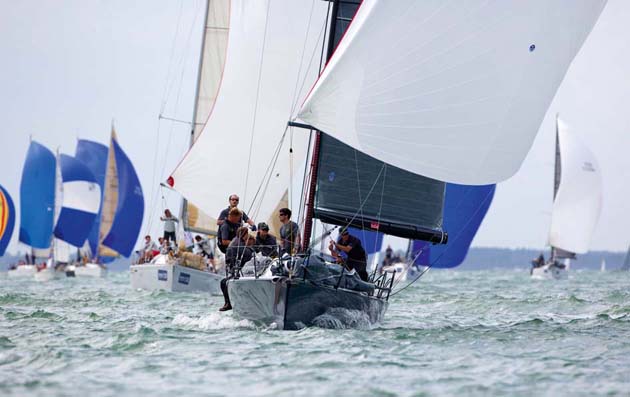Adam Gosling and designer John Corby revamped the classic 36ft racer Mustang Sally to turn her into the 12th Yes!
Adam Gosling likes to win. Over the past 25 years he has competed at every Cowes Week and won his class on 12 occasions, three times winning Black Group overall. He has succeeded at international level too, winning the highly competitive Etchells World Championship in 1996 with Olympians Mark Covell and David Howlett as crew. His contact list includes some of the best sailors in the world and he is married to double Gold medallist Sarah Webb, adding to an already enviable sailing network.
Gosling has the ability, focus, will and, to be blunt, the financial means to compete at pretty much any level he should choose. Yet given all this, Gosling has a disarmingly down-to-earth approach to his sailing.
While others might commission complex one-offs or undertake major reconfigurations of large grand-prix racers to chase prestigious silverware in the glamorous headline-grabbing classes, Gosling bought an 18-year-old, tired-looking, well-used 36ft boat and fitted a new rig and sailplan. Two months later he walked away with the top trophy at Cowes 2013, and all for half the price of a new boat. This is how he did it.
He began by choosing a designer with whom he had worked and sailed with for a number of years and who has a long and successful track record in IRC racing. Designer John Corby has not only proved that he can create fast boats straight off the drawing board, but also that he can breathe new life into earlier models. In recent years Corby has been busy refurbishing his older raceboats with such success that they have been reclaiming the podium.
Gosling’s latest Yes!, his 12th boat bearing that name, was one of Corby’s early successes. Originally named Mustang Sally, she was a ground-breaking, loophole-busting, trophy magnet in the early days of IRC. But while this 36-footer claimed the silverware and headlines in the mid nineties – she scored 33 firsts from 53 starts in her first season – she was not popular with the IRC rule administrators.
Corby had exploited a weakness in the rule whereby heavy displacement was seen as slow when compared with the modern lightweight flyers. She may have been heavy, but there was nothing slow about Mustang Sally’s hull shape which, as has been proved 18 years later, was both modern and ahead of her time. Putting a heavy bulb keel on a slinky modern hull generated large amounts of unmeasured righting moment and hence power.
What is perhaps most extraordinary about the reworking of this modern racing classic is that only the rig and sailplan were changed. Her hull, deck and underwater appendages are original, with one exception: the keel was changed in 2005 and refaired to a different section in 2013.
“Adam’s previous boat was a 30-footer in which he’d won his class at Cowes three times and come 2nd once,” says Corby. “This time he wanted a boat that was slightly bigger so that his tactician, David Howlett, didn’t have to do the mainsheet. He also wanted a boat that would get into a bigger class at Cowes. On the other hand he didn’t want to be racing against boats like the King and Ker 40s. A 36-footer fitted the bill perfectly.
“We bought Mustang Sally in Kilrush last Easter. Given her state we knew it was going to be a daunting task to have her in the water 11 weeks later. We spent 2,500 man hours on reconfiguring her, yet this was still 2,000 hours less than building a new boat of the same size.” Another benefit of buying a second-hand boat was the age allowance that came with it, which Corby estimates is probably worth around a minute per hour.




